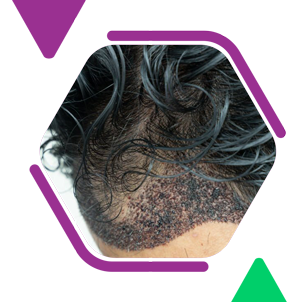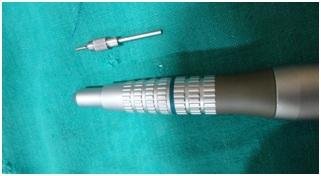
Follicular Unit Extraction (FUE) is a minimally invasive hair transplant treatment that is well tolerated by patients. It involves the removal of hair follicles from the donor area to be transplanted into the desired area. Follicular Unit Extraction has become increasingly popular in recent years due to its less invasive nature and reduced scarring. The recovery time is also shorter compared to the strip method. However, Follicular Unit Extraction can be more time-consuming due to the precision required to extract individual follicles. At Saundarya City, get the best treatment for Follicular Unit Extraction hair transplant in Nagpur.The main procedural difference between Follicular Unit Extraction and the traditional strip FUT technique is the way the graft is extracted or obtained from the donor area. With Follicular Unit Extraction, each follicular unit (FU) graft is harvested individually with a small micro-punch.
A 0.8 to 0.9 mm punch is used to make small circular incisions in the skin around the upper part of the follicular unit, which is then extracted (pulled) directly from the scalp, leaving a tiny hole.
This process is repeated until the surgeon has enough grafts to perform the procedure. Once they are harvested, the rest of the procedure (recipient site creation and transplantation of grafts) is essentially the same for both techniques.
The difference between these two procedures lies in the appearance of the donor area and the difference in the number and fragility of the grafts produced. Though a linear scar is not created, thousands of tiny punches can cause visible white dots or a moth-eaten look in the donor area in some patients. Try the best Follicular Unit Extraction technique hair transplant in Nagpur at Saundarya City.
Advantages of Follicular Unit Extraction:
Follicular unit transplantation in Nagpur is a safe and effective hair restoration method for those experiencing hair loss or thinning. Some of its advantages are:
– A linear incision isn’t required, hence no linear scar is made in the donor area.
– The Follicular Unit Extraction technique in Nagpur is usually preferred for patients with a history of hypertrophic scars or keloid tendencies.
– It is useful in patients with tight and inflexible scalps or scars from previous surgery.
– It is also useful for harvesting body hairs from the beard, chest, limbs, back, pubic, and axillary regions.
Disadvantages of Follicular Unit Extraction:
– The total number of grafts harvested is less because with Follicular Unit Extraction one needs to leave about 50% of the grafts behind to avoid creating a bald patch in the donor area.
– Grafts are more delicate and fragile because they strip off protective tissue during the extraction process. Hence they are more prone to dehydration, trauma, and poor growth.
– The entire donor area has to be shaved to extract the FUs. This can create significant inconvenience for many patients.
When does hair start growing?
Hair growth starts after 3 to 4 months of surgery. Visible changes are seen after 4 months, but they usually are new hairs that are immature. Normal hair growth takes almost 6 to 8 months into the maturation stage until 2 years. Consult our qualified hair transplant surgeon to determine the suitable criteria and get an advanced Follicular Unit Extraction technique in Nagpur!
Follicular Unit Extraction
Follicular Unit Extraction is a minimally invasive hair transplant procedure renowned for its patient-friendly approach and high success rate. Unlike traditional hair restoration methods, Follicular Unit Extraction involves the meticulous extraction of individual hair follicles from a donor area, typically the back or sides of the scalp, and their transplantation into the desired areas experiencing hair loss. The technique’s growing popularity can be attributed to its minimally invasive nature, reduced scarring, and quicker recovery time compared to the strip method or Follicular Unit Transplantation (FUT).
At Saundarya City, we provide the best Follicular Unit Extraction hair transplant treatment in Nagpur, ensuring our patients receive top-tier care and achieve optimal results. This guide will delve into the intricacies of the Follicular Unit Extraction procedure, its advantages and disadvantages, and what patients can expect in terms of hair growth and recovery.
Understanding the Follicular Unit Extraction Procedure
The Extraction Process
The primary distinction between Follicular Unit Extraction and the traditional strip FUT technique lies in how grafts are harvested from the donor area. In Follicular Unit Extraction, each follicular unit (FU) graft is extracted individually using a small micro-punch tool. This punch tool, typically measuring 0.8 to 0.9 mm in diameter, creates tiny circular incisions around the upper part of each follicular unit. The surgeon then carefully extracts the follicular unit from the scalp, leaving a small hole that heals with minimal scarring.
This extraction process is repeated numerous times until the surgeon has collected enough grafts to complete the transplantation. The precision required for this method means that Follicular Unit Extraction can be more time-consuming than FUT, but it also results in a more natural appearance with less noticeable scarring.
Transplantation
Once the necessary grafts are harvested, the rest of the procedure mirrors that of the FUT technique. The surgeon creates recipient sites in the balding or thinning areas of the scalp and meticulously implants each follicular unit. The careful placement of these grafts ensures that the hair grows in a natural direction and pattern, contributing to a seamless and aesthetically pleasing result.
Advantages of Follicular Unit Extraction
Follicular Unit Extraction offers several significant advantages over traditional hair transplant methods, making it an attractive option for many patients.
Minimal Scarring
One of the most significant benefits of Follicular Unit Extraction is that it does not require a linear incision, thus avoiding the linear scar associated with the FUT technique. Instead, the tiny circular incisions made during Follicular Unit Extraction leave small, dot-like scars that are often difficult to detect, even with short haircuts. This makes Follicular Unit Extraction particularly suitable for individuals who prefer to keep their hair short or who are concerned about visible scarring.
Suitable for Various Scalp Conditions
Follicular Unit Extraction is an excellent choice for patients with specific scalp conditions that make traditional methods less feasible. For instance, individuals with tight or inelastic scalps, hypertrophic scarring, or a tendency to develop keloids can benefit from Follicular Unit Extraction, as the procedure is less invasive and less likely to exacerbate these issues. Additionally, Follicular Unit Extraction can be used to harvest hair from various parts of the body, including the beard, chest, back, and limbs, providing more donor options for patients with limited scalp hair.
Faster Recovery
The recovery time for Follicular Unit Extraction is generally shorter compared to FUT. Patients typically experience less post-operative discomfort and can return to their normal activities sooner. The small wounds created during Follicular Unit Extraction heal rapidly, reducing the risk of infection and other complications.
Disadvantages of Follicular Unit Extraction
Despite its many advantages, Follicular Unit Extraction also has some drawbacks that patients should consider.
Limited Graft Harvesting
One of the main limitations of Follicular Unit Extraction is that the total number of grafts harvested is often less than what can be achieved with FUT. This is because approximately 50% of the donor hair must be left behind to prevent creating a bald patch in the donor area. As a result, patients requiring a large number of grafts may need to undergo multiple Follicular Unit Extraction sessions or consider alternative methods.
Delicate Grafts
The grafts harvested during Follicular Unit Extraction are more delicate and fragile compared to those obtained through FUT. This is because the extraction process strips away some of the protective tissue surrounding each follicle, making them more susceptible to dehydration, trauma, and poor growth. Surgeons must handle these grafts with utmost care to ensure their survival and successful transplantation.
Shaving the Donor Area
Another inconvenience associated with Follicular Unit Extraction is the necessity to shave the entire donor area to facilitate the extraction of follicular units. This can be a significant drawback for patients who are concerned about the aesthetic impact of a shaved scalp, especially in professional or social settings.
Post-Procedure and Hair Growth
Initial Recovery
Immediately following a Follicular Unit Extraction procedure, patients may experience some redness, swelling, and mild discomfort in both the donor and recipient areas. These symptoms typically subside within a few days. Patients are advised to follow post-operative care instructions meticulously, including avoiding strenuous activities and direct sunlight, to ensure proper healing.
Hair Growth Timeline
Hair growth after a Follicular Unit Extraction transplant follows a predictable timeline. Initially, transplanted hairs may fall out within the first few weeks, a normal part of the hair growth cycle known as “shock loss.” New hair growth typically begins around 3 to 4 months post-surgery.
– First 3 to 4 Months: Transplanted hairs shed and new hair growth starts. At this stage, new hairs are often fine and immature.
– 4 to 8 Months: Significant hair growth becomes noticeable. The new hairs begin to thicken and mature, providing a fuller appearance.
– 8 to 12 Months: Continued hair growth and maturation. The transplanted hair gains more density and starts blending naturally with existing hair.
– 12 to 24 Months: Final results are visible. Hair continues to thicken and mature, reaching its full potential in terms of density and length.
Follicular Unit Extraction hair transplant has revolutionized the field of hair restoration, offering a minimally invasive alternative with numerous benefits over traditional methods. Its ability to minimize scarring, accommodate various scalp conditions, and provide faster recovery times makes it an appealing option for many patients.
At Saundarya City in Nagpur, we are committed to providing the best Follicular Unit Extraction hair transplant treatment, leveraging advanced techniques and experienced surgeons to deliver exceptional results. Whether you are experiencing hair loss or thinning, our team can help you regain confidence and achieve a natural-looking head of hair.


Follicular Unit Extraction (FUE) is a minimally invasive hair transplant procedure renowned for its patient-friendly approach and high success rate. Unlike traditional hair restoration methods, FUE involves the meticulous extraction of individual hair follicles from a donor area, typically the back or sides of the scalp, and their transplantation into the desired areas experiencing hair loss. The technique’s growing popularity can be attributed to its minimally invasive nature, reduced scarring, and quicker recovery time compared to the strip method or Follicular Unit Transplantation (FUT).
At Saundarya City, we provide the best FUE hair transplant treatment in Nagpur, ensuring our patients receive top-tier care and achieve optimal results. This guide will delve into the intricacies of the FUE procedure, its advantages and disadvantages, and what patients can expect in terms of hair growth and recovery.
Our Services
- Hair Loss
- Causes of Hair Loss
- Clinical Features
- Laboratory Test
- Medical Treatment
- Cyclic Treatment
- PRP
- Hair Transplant
- Surgical Treatment
- FUE
- FUT
- Beard Reconstruction
- Moustache Reconstruction
- Eyebrow Reconstruction
- Side Burn Reconstruction
- Complications of Hair Transplant
- Alopecia Areata
- Telogen Effluvium
- Laser Treatment



 Book an Appointment
Book an Appointment